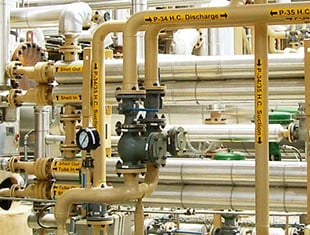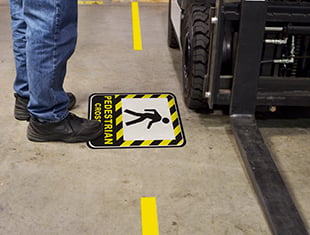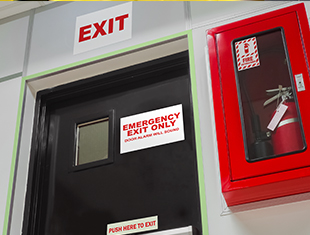Ammonia Pipe Marking
Webinar | Ammonia Pipe Marking
Ammonia Pipe Marking
Improve the safety of complex ammonia refrigeration systems with ammonia pipe marking. In this 10-minute webinar, Compliance Specialist Brian McFadden will explain the latest guidelines from the International Institute of Ammonia Refrigeration (IIAR), elements of a typical ammonia pipe marking label, and solutions to streamline the label process.
 10 MINS
10 MINS Presented By

Brian McFadden
Technical Writer
Compliance Specialist
Related Resources
Transcript
Webinar Preview
Contents of the Ammonia Pipe Marking Webinar:
- The importance of pipe marking for ammonia-based refrigeration systems
- The recommended standards for ammonia pipe marking
- What these pipe labels need to include, and
- How to create a pipe marking system for your facility
Excerpt from the Ammonia Pipe Marking Webinar transcript:
The Importance of Ammonia Pipe Marking
Ammonia refrigeration is a powerful and efficient way to keep things cool, from frozen foods to ice rinks. However, these industrial refrigeration systems keep large amounts of anhydrous ammonia under pressure, and pump it through large and complex networks of pipes and equipment. The risk of accidental exposure is a serious threat to worker health and safety.
Ammonia is corrosive to the skin, eyes, and lungs, and can cause severe chemical burns, even from brief exposure. Several workers have died from accidental releases of the material. Even when an accident doesn't cause serious injuries, bringing the system back online can require extensive downtime for purging, cleaning, and repairs. Clear and careful labeling can streamline ordinary maintenance and reduce the risks of accidents, damage, and injury. If your facility's refrigeration systems use anhydrous ammonia as a refrigerant, you should follow the experts' recommendations for ammonia pipe marking.
Pipe Marking Standards
The International Institute of Ammonia Refrigeration, or IIAR, provides a voice for these expert recommendations. Last updated in April 2014, the IIAR Bulletin No. 114 standard offers a uniform system for labeling ammonia refrigeration piping and system components to promote safety and simplify maintenance. The system is also compatible with ANSI/ASME A13.1, the most widely-used general facility pipe marking standard in the United States.
Building on ANSI/ASME A13.1
Under the ANSI/ASME A13.1 framework, a facility's pipe labels need to:
. clearly identify the contents of the pipe,
. indicate the general functions or hazards of those contents,
. and show which way those contents are flowing
To accomplish this, standardized pipe labels use
. bold text to name the pipe's contents,
. a color code to show the general category for the pipe,
. and arrows to point out the direction of flow
The ANSI/ASME standard also provides guidance on how large to make the labels, ensuring that they can be seen and read easily. The sizing recommendations are based on the size of the pipe - specifically, the outer diameter of the pipe, including any insulation or other covering.
Additionally, the general standard makes recommendations for where to place pipe labels, and how often to repeat them, to maximize label visibility. For example, pipe labels should appear on either side of a wall penetration, near any valve, and repeating periodically along straight runs of pipe. Where a pipe will be seen from above or below, placing the label on the upper or lower part of the pipe can be necessary for readability.
IIAR Bulletin No. 114
The IIAR standard builds on this foundation. Typical ammonia pipe labels will use the word "Ammonia" and a printed arrow, to show what's in the pipe and which way it's going; the main body of the label will be orange, to match the ANSI/ASME recommended color for labeling pipes of toxic materials.
With ammonia refrigeration, though, there are some additional details that are important. With the size and complexity of industrial refrigeration systems, it's often necessary to identify specific parts of the system, or the functions of specific pipes or equipment. Additionally, workers may need to know the physical state and pressure level of the ammonia at a given point, in order to perform their work safely. The IIAR standard adds pipe labeling elements to cover these details.
Now let's look into the key elements of an ammonia pipe label.
Components of an Ammonia Pipe Marker
There are two different types of labels described in the IIAR standard:
. pipe labels, which use a five-part construction,
. and component labels, which use a simpler, two-part construction
To learn the about common types of visual signals, and practical guidance on maximizing the value of visuals in your facility, watch the full webinar on demand now!
Related Resources

Practical Pipe Marking
Presented By Brian McFadden Technical Writer Compliance Specialist Related Resources Ammonia Pipe Marking ...
Watch Now
Productive Floor Marking
Presented By Brian McFadden Technical Writer Compliance Specialist Related Resources Floor Marking Placement ...
Watch Now
Preparing for Facility Emergencies
Presented By Brian McFadden Technical Writer Compliance Specialist Related Resources Emergency Preparation ...
Watch Now.png)





